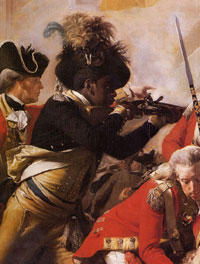|
| |
Ethiopian Regiment
During their southern campaign in 1780, the British aimed to alarm the Colonists by inciting massive slave revolts. Lord Dunmore, as Royal Governor of Virginia, sought to disrupt the efforts of the |
| |
patriots by promising freedom to their slaves in exchange for military service with the royal army.
Not only would this create civil unrest, but it could potentially cripple the nation's slave driven economy.1
Lord Dunmore's Proclamation in November 1775 promised freedom to all slaves that could cross British lines and join the royal army. The strategy was successful; nearly 800 runaway slaves joined Dunmore nearly doubling his troops. One of the more prominent members of the regiment was runaway slave Titus, later known as Colonel Tye. A slave named Yellow Peter served in Dunmore's regiment and became known as Captain Peter.2
From these runaways, Dunmore formed the Ethiopian Regiment. The regiment was trained in formation marching and musket shooting. On their uniforms, they proudly had embroidered the slogan, "Liberty to Slaves" in order to antagonize the liberty seeking patriots.3 |
 |
| |
The Ethiopian Regiment easily overtook the Americans at Kemp's landing with the use of a surprise attack. Overconfident, Dunmore ordered the group to attack fortified positions at Norfolk. It was there that they suffered a debilitating defeat at the Battle of Great Bridge.4
After their defeat, the regiment was forced to withdraw. After Dunmore's troops boarded onto the British fleet, many of the soldiers died of disease and others were evacuated and granted their freedom in exile. 5
|
| |
Next >
|
| |
| |
|



